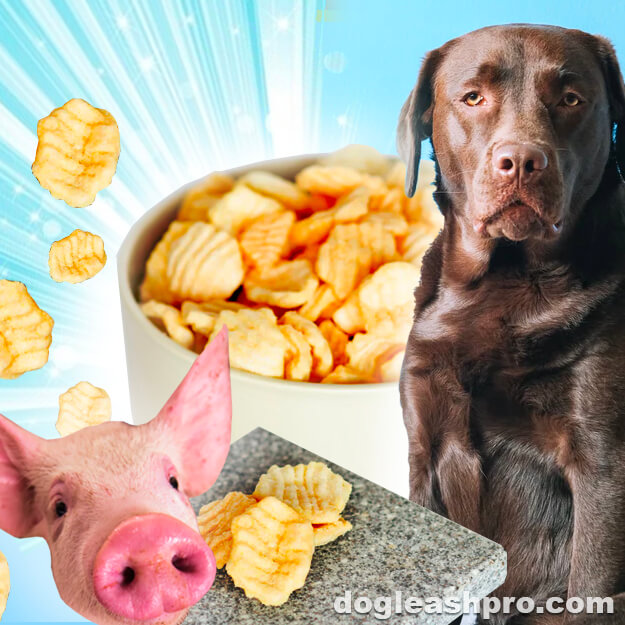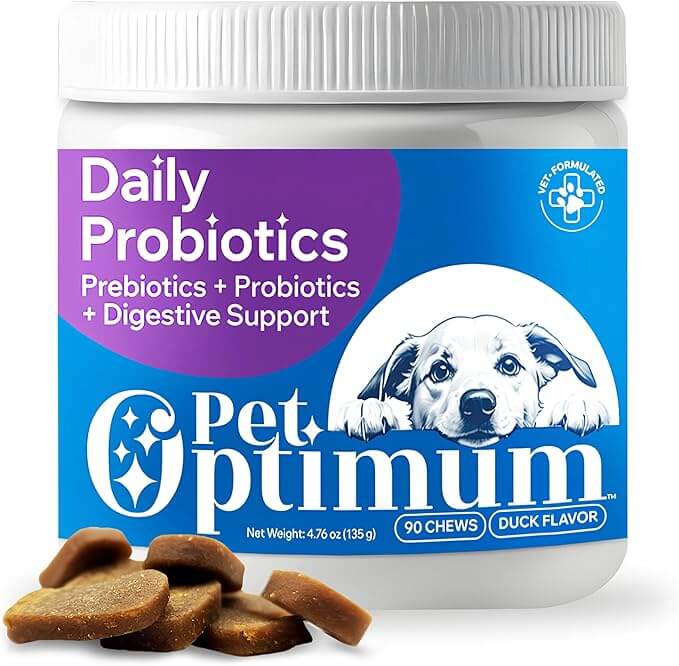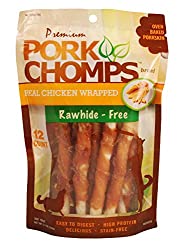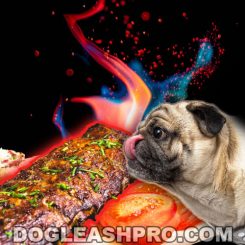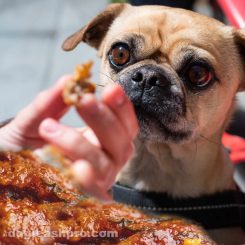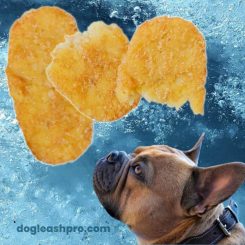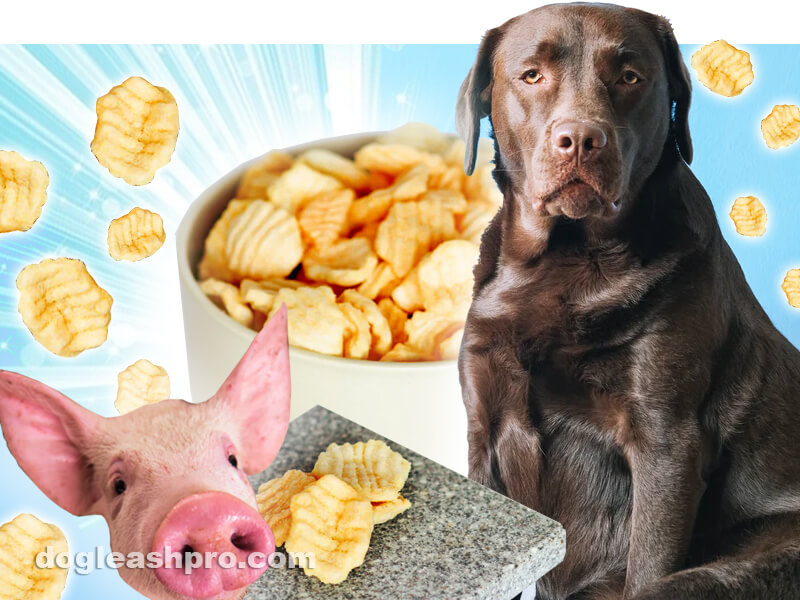
Last weekend, I decided to switch up the ingredients in my salad and add Pork rinds instead of croutons for that crunchy flavorful mix. I made spicy chicken salad with crispy pork rinds and it was delicious! The only problem – my Labrador sat by my foot waiting for me to give her a piece but I was worried it may be unhealthy for her.
Can dogs eat Pork rinds? No, dogs should not eat Pork rinds. While the pork is fine for dogs to eat, the pork “rinds” are not as they contain tons of ingredients such as salt, bad fat, and spices that are harmful to canines. Additionally, the oil that is used to fry pork rinds is not dog-friendly.
Whichever name you have for Pork Rinds – whether they be chicharrones, crackling, pork skin, or scratchings – this is a salty processed food that is unhealthy for our canines. Let’s dive deeper and discuss the ingredients in Pork rinds, how these ingredients are harmful to our pooch, and what dog-friendly treat alternatives you can give your pups instead.
Table of Contents
What are Pork rinds?
They are a snack that is meant to satisfy the human palate or taste buds for the savory, oily and salty flavor as well as crunchy taste. Some people love to deep fry the Pork rinds while others prefer to lightly fry them in a grill or pan.
Whichever way you prefer, we can all agree that Pork rinds are made from the pigs’ skin that has been deep-fried.
While we consider Pork rinds as snacks, they are actually a staple food found in many areas around the globe. For instance, Pork rinds are known as chicharrones in Mexico. You’ll also find people in the Southern United States enjoying this popular snack.
Are Pork rinds safe for dogs to eat?
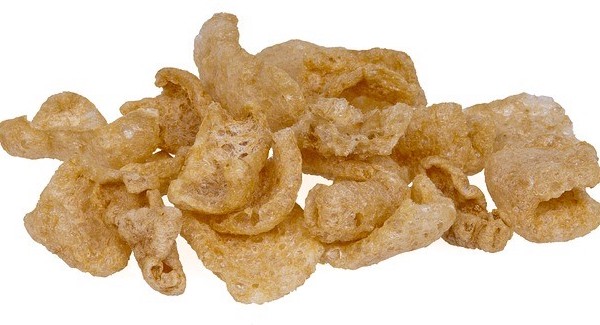
It is not safe for dogs to eat Pork rinds on a regular or daily basis. While this salty food is not entirely toxic to dogs, you should avoid feeding your pooch Pork rinds.
Due to the amount of salt, oily grease, and fat in Pork rinds, eating this on a regular basis can cause dehydration, upset stomach, and eventually weight gain in dogs.
Let’s take a look at the ingredients in Pork rinds.
What are Pork rinds made out of?
The Pork rinds snack bag you see at your local grocery store looks like it is easy to make, but you’ll be surprised at how many steps it takes to make them.
Pig skin in addition to different parts of the pork
Pork rinds are mainly made out of pig skin. The pig skin is then blended or combined with other parts of the pork such as gristle, fats, and other sinewy bits. By blending the skin with other sinewy bits of the pork, it helps to make this snack savory for human consumption.
Fun Fact: Similar to Pork rinds, Chicken nuggets are made with 50% chicken meat and the rest is ground bone, connective tissues, blood vessels, and fat.
Fried pig skin
First, the pigskin is boiled so that it is soft. The skin of the pig is then cut into small strips or pieces and dehydrated at a cold temperature until it is brittle and browned. Next, it is deep-fried at a very high temperature until it turns crispy and puffy.
Spices and seasonings
That’s not all. Seasonings like salt and pepper are then added to this crispy and puffy snack. It’s not uncommon to have the following seasoning on Pork rinds:
- Garlic and onion.
- Salt and vinegar.
- Barbecue.
- Cinnamon-sugar.
Therefore, while the pork skin is fine for dogs to eat, how the Pork rinds are made and the seasonings used are harmful and potentially toxic to dogs.
Let’s discuss each one:
Pork skin (fine to eat)
It is safe for dogs to eat Pork skin whether it is cooked or raw. If you’re giving your pooch plain cooked pork skin that is not fried in oil or has any added seasoning, then it should be fine for dogs to eat.
Oil (Can be harmful)
Pork rinds are deep-fried in oil that is not canine-friendly. The best oils for dogs are olive oil and coconut oil. We can tell you that both of these oils are not used during the Pork rind deep-fried process.
In fact, some of the oil used to fry the Pork rinds come from the fats underneath the pork skin. This is not healthy for dogs. In fact, your four-legged friend may start vomiting or have diarrhea to try to get rid of that oil from his body.
The oil from the Pork rind can also cause canine obesity. In some cases, he may develop pancreatitis.
Garlic and onion (Harmful)
Both onion and garlic belong to the allium family, which means they contain thiosulfate. Thiosulfate can damage your pup’s red blood cells and cause hemolytic anemia, which is why both onion and garlic are extremely toxic to dogs.
Canines with hemolytic anemia will display the following symptoms:
- Fast breathing.
- Muscle weakness.
- Lethargy.
- Pale or white mucous membranes.
- Dark-colored urine.
- Jaundice.
It’s best to keep the garlic away from your pup so he can’t reach it. If he consumes a good amount of garlic, he may experience garlic toxicity and have the following symptoms:
- Diarrhea.
- Vomiting.
- Abdominal pain.
- Dehydration.
- Loss of appetite.
- Depression.
Hint: Since onion and garlic are both toxic to dogs, it’s best to avoid feeding our canines food such as Lasagna that contains these two ingredients.
Salt (Fine in small amount)
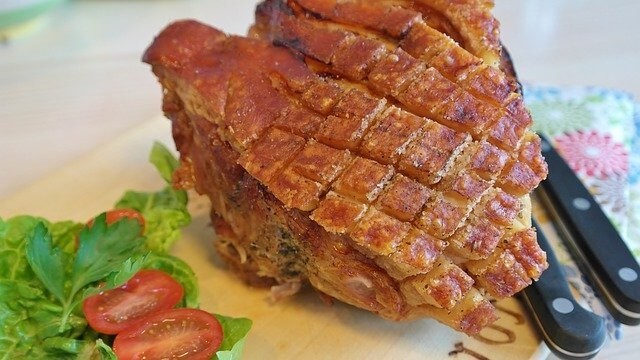
Most dog food will only contain the necessary amount of salt that dogs need daily. Consuming a small amount of salt is fine for dogs as it is important to have some in their diet, however, too much salt is harmful to dogs.
This is why it’s never a good idea to share our salty snacks like the Pork rinds with your canine friends. As a result of being very thirsty, your pooch may also need to go potty more often.
In severe cases, your pup may even have sodium ion poisoning. Here are the symptoms of salt poisoning:
- Tremors.
- Seizures.
- Vomiting.
- Depression.
- High temperature.
- Diarrhea.
Vinegar (Harmful)
Vinegar used in Pork rind flavoring is usually undiluted. When dogs ingest human food that contains vinegar, they can get an upset stomach or gastrointestinal upset.
If you know your furry friends have kidney disease or failure, it is best to keep the vinegar away from them. The same goes for dogs that are sick, not completely healthy, or have sensitive stomachs.
Signs that your pup has gastrointestinal upset includes:
- Dehydration.
- Vomiting.
- Diarrhea.
Barbecue (Harmful)
Barbecue sauce is harmful to dogs. It can cause your dog to vomit or have diarrhea shortly after ingesting food with barbecue sauce. When sharing any meat with your pup, make sure it is plain without any seasonings.
The reason why barbecue sauce is harmful to our pups is that it has a high salt and sugar content. This can cause canine obesity or salt toxicity.
Some barbecue sauces also contain toxic ingredients like onion and garlic. Be sure that your canine companion stays away from spicy barbecue as well.
Cinnamon-sugar (Fine in small amount)
While cinnamon, in general, is safe for dogs, cinnamon-sugar is not. Again, sugar is the problem, and ingesting too much sugar can cause weight gain and ultimately lead to canine obesity.
These are all the reasons why you should keep Pork rinds away from your precious pooch.
Fun Fact: Dogs that consume too much sugar can start to gain weight and develop dental issues. It’s best that you avoid giving your pups sugary snacks like Fortune cookies if they are already diabetic, overweight, or have tooth decay.
When shouldn’t you feed Pork rinds to your dog?
You shouldn’t feed your dog Pork rinds if they are overweight, have sensitive stomachs, kidney failure or disease, are not 100% healthy, or are sick.
Do Pork rinds provide any nutritional benefit for your dog?
No, Pork rinds do not provide many nutritional benefits for your dog. The way Pork rinds are prepared is extremely toxic to dogs. Deep-fried Pork rinds are loaded with calories and ingredients that are harmful to dogs.
Eating this fatty and fried food regularly can cause both canine obesity, diabetes, digestive upset, and upset stomach. These health problems can shorten your canine’s life. Your canine companion may even live a poor quality of life.
It’s best that your dog sticks to his regular dog food diet that is well-balanced and healthy so he gets only the calories he needs.
Speaking of calories, let’s discuss the number of calories in Pork rinds:
Calories in Pork rinds
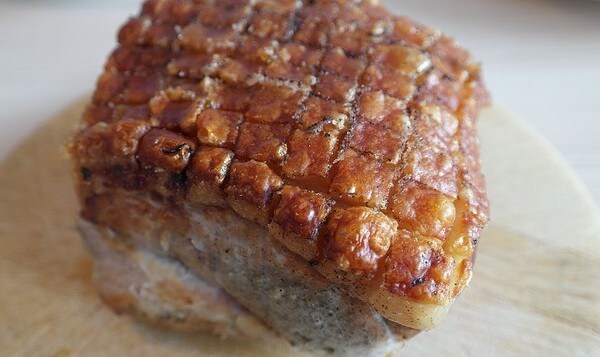
Dogs should only consume 25 calories for each pound they weigh. Let’s take these two dog breeds as an example:
- An average Chihuahua of 7 pounds should have no more than 175 calories per day.
- An average Labrador of 70 pounds should have no more than 1,750 calories per day.
With this calculation in mind, here are the calories from some of the common Pork rind brands you find at your local grocery store:
- Utz Pork Rinds 30g (171 calories): 97% Chihuahua / 10% Labrador
- Microwave Pork Rinds 30g (128 calories): 73% Chihuahua / 7% Labrador
- Mac’s Pork Skins 30g (171 calories): 97% Chihuahua / 10% Labrador
- Mac’s Pork Crackling 30g (107 calories): 61% Chihuahua / 6% Labrador
Keep in mind the 90/10 rule in which 90% of calories should be from a well-balanced diet and only 10% of the calories should come from dog treats.
If you take a look at the calories count, the Pork rind takes up a large proportion of the small dog’s daily calories while it completes or almost completes the 10% dog treat calories.
Due to this, we recommend that if you have small or medium-sized dogs, avoid feeding them Pork rinds. If you have large dog breeds, feeding them Pork rinds means you can’t give them any other treats for that day.
Fun Fact: If you’re drinking sugary soda like Sprite, avoid giving your pooch this caffeinated beverage. It’s full of sugar and also does not provide any nutritional benefits for your dog.
Can dogs eat pork skins?
Yes, dogs can eat pork skins if they are home-cooked with no added flavor or oil. Plain fully cooked pork skins are fine for dogs.
However, if the pork skins are bought from the store, avoid feeding that to your four-legged friends. These pork skins are similar to Pork rinds in that they are probably fried in bad oil and doused with salt and seasonings. Also, the way they were made may not offer any nutrient benefits to your pup.
Can dogs eat Pork scratchings?
No, dogs should not eat Pork scratchings. Pork rinds in the UK are called Pork scratchings. Since it is the same food, dogs should not eat it. This is especially true if you’ve bought your Pork scratching from the grocery store or supermarket.
Can dogs eat Pork crackling?
No, dogs should not eat Pork crackling. People in the US, UK, and Australia will use the term Pork crackling. It is called Pork crackling because some people cook the pork at home and cut skin or crackling out of the pork.
The Pork crackling can still contain salt, oil, and seasonings on it. The Pork crackling is also very oily and can cause pancreatitis in dogs if they consume it regularly.
Some people like to use onion or garlic as seasonings on the Pork crackling. If this is the case, do not feed this Pork crackling to your pooch.
Can dogs eat fried Pork rinds?
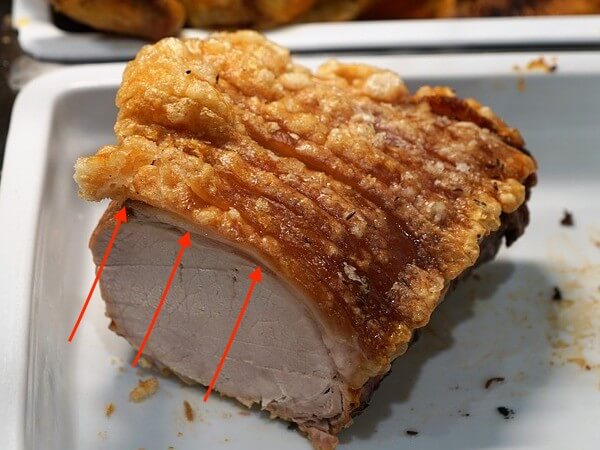
No, dogs should not eat Pork rinds due to the amount of fat, oil, salt, and seasoning that are in Pork rinds. Ingesting lots of fried Pork rinds can cause health issues including pancreatitis, which needs to be attended to as soon as possible.
Can you give dogs Pork rinds that humans eat?
No, you should not give dogs Pork rinds that humans eat. Pork rinds made for human consumption contains tons of oil, salt, and other seasonings that are dangerous for dogs.
Fun Fact: Some human candies like Altoids are dangerous for our dogs. They may contain a high amount of sugar and some may contain sugar substitutes such as xylitol. Xylitol is very toxic to dogs and can even lead to hypoglycemia, liver failure, and seizure in dogs.
Can dogs eat Pork rinds chips?
No, dogs should not eat Pork rinds chips. These chips are bite-sized, just like the Pork rinds so they are prepared the same way with tons of oil, salt, and seasonings that may be toxic to dogs.
Can dogs eat spicy Pork rinds?
No, dogs should not eat spicy Pork rinds. We’ve blogged about how spicy food can be harmful to our precious furry friends. You’ve probably read our post on Can Dogs eat Takis. If you have spicy Pork rinds sitting around, keep them on high surfaces or in locked cabinets.
When dogs eat spicy food, they will have the following symptoms:
- Abdominal pain.
- Passing gas.
- Vomiting.
- Diarrhea.
- Dehydration.
Can dogs eat raw Pork rind?
No, dogs should not eat raw Pork rind. It is advised that you should never feed your pooch raw or undercooked Pork as it may be contaminated or could contain a harmful parasite called trichinella spiralis larvae.
Once your pup ingests a raw Pork rind that has this parasite, he may have trichinosis, a parasitic infection.
Merck Manual of Veterinary Manual states that:
“Trichinellosis is a parasitic disease that can be transmitted to people. It is caused by a type of worm known as a nematode…People become infected when they eat undercooked infected meat, usually pork…although other animals can also be infected with this nematode. Natural infections occur in wild meat-eating animals; most mammals are susceptible.”
So we recommend that you do not give your pup any raw Pork rinds.
What will happen if my dog eats Pork rinds?
Luckily, in most cases, your dog will be fine if they eat a little bit of Pork rinds, chicharrones, crackling, pork skin, or scratchings. Before you feed them Pork rinds, make sure your pup is not allergic to pork. Be sure to also provide him a bowl of fresh water since there is a lot of salt in Pork rinds.
If you’re unsure how your pup may react from eating Pork rinds, it is a good idea to speak with your vet first and ask for their professional advice.
Here are the symptoms you should look for after your canine companion has ingested Pork rinds:
Upset stomach or digestive upset
After ingesting Pork rinds, your pooch may vomit, have diarrhea, or have stomach pain. It can also affect his physical state such that he is unable to walk properly, is hunched over or curled up, or has touch sensitivity.
Watch his behavior carefully and see if the symptoms are short term of about 24 hours. After the 24 hour period, it’s best to only give him his regular dog food.
If his symptoms are persistent after the 24 hour period, it’s best to bring him to the vet.
During this time, make sure your canine friend is hydrated by providing fresh water nearby.
Ask your vet if they would recommend PetOptimum Probiotics for Dogs, a probiotic for canines that can help restore balance in their digestive tract.
Sodium poisoning
Salt poisoning is serious because it means there is an imbalance in the dog’s bodily fluids. You may see the following physical reactions from salt poisoning:
- Vomiting.
- Diarrhea.
- Muscle tremors.
- High fever.
- Weakness.
- Frequent potty or urination.
- Seizures.
- Depression.
- Dehydration and very thirsty.
Consult with your vet as soon as you notice your pup has salt poisoning.
Dog-friendly alternatives to Pork rinds
Knowing the dangers of Pork rinds for my canine companions, I give them these canine-friendly pork dog treats instead:
So, can dogs eat Pork rinds?
It’s best not to give our pups Pork rinds. This tasty, salty, and crunchy snack is made for human consumption to satisfy the human taste buds. Since it is deep-fried in oil that is not dog-friendly, Pork rinds can be toxic to dogs.
As responsible dog owners, we should make sure we do what’s best for our canine companions.
DISCLAIMER: THIS WEBSITE DOES NOT PROVIDE MEDICAL ADVICE
The information, including but not limited to, text, graphics, images and other material contained on this website are for informational purposes only. No material on this site is intended to be a substitute for professional veterinary advice, diagnosis, or treatment. Always seek the advice of your veterinarian or other qualified health care provider with any questions you may have regarding dietary needs.
Resources:
https://en.wikipedia.org/wiki/Pork_rind
https://healthyrecipesblogs.com/homemade-pork-rinds/

With over five years of specialized experience as an animal writer, my expertise lies in dog nutrition, health, behavior, grooming, and training. I am dedicated to delivering helpful and informative content that caters to the well-being of our furry friends. My primary goal is to empower pet owners with knowledge and ensure our canine companions thrive in health and happiness. In my free time, I love volunteering at local dog rescue centers.
